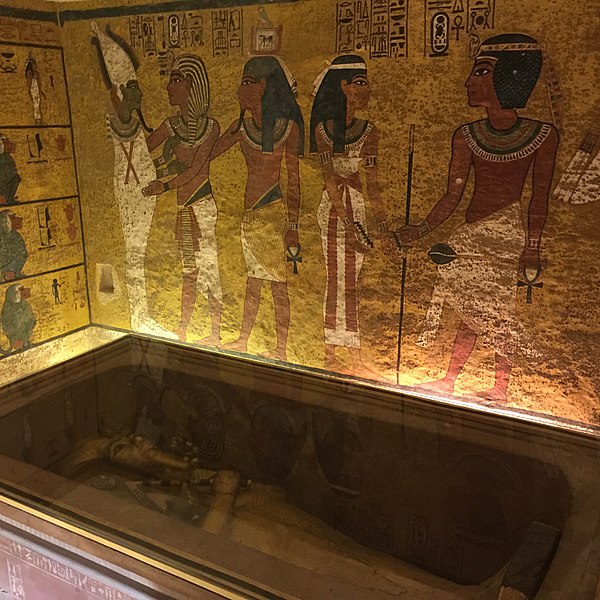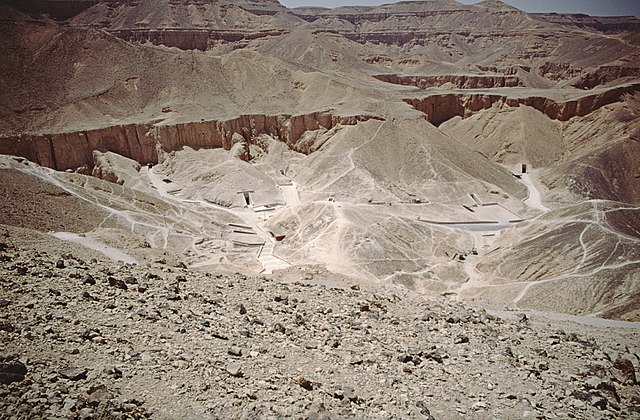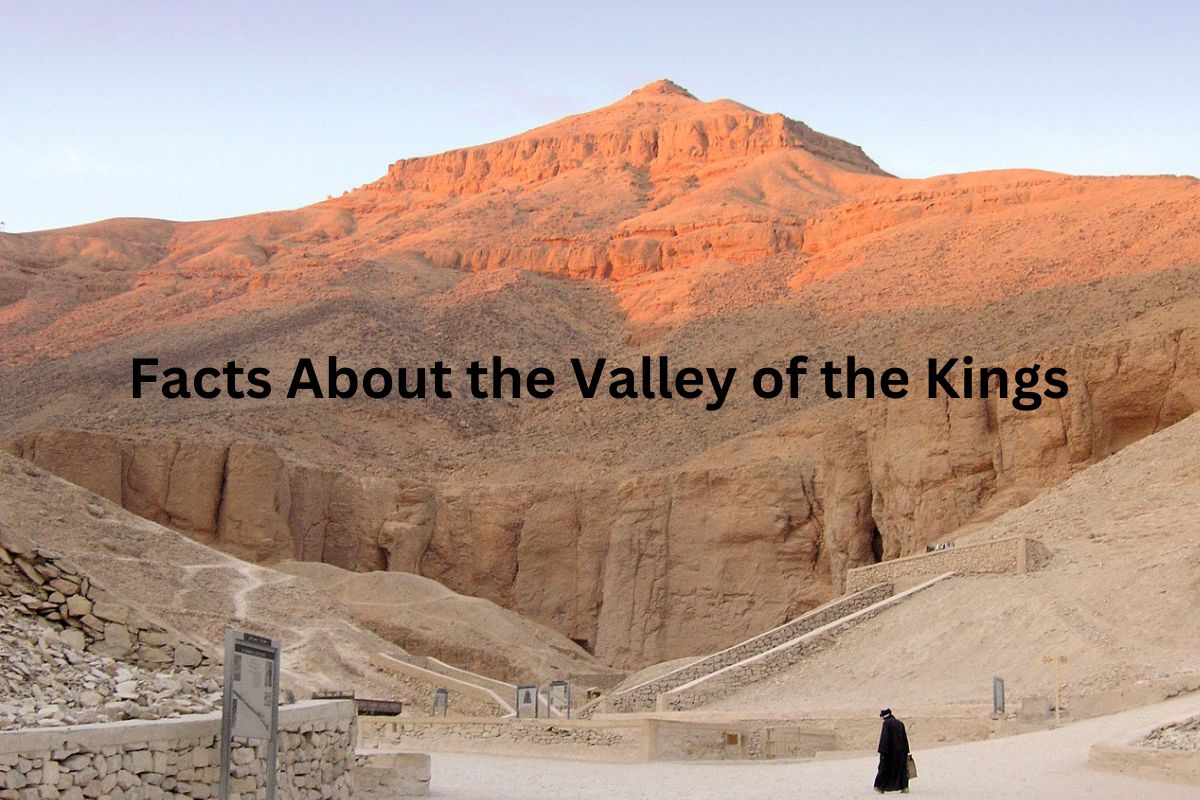The Valley of the Kings, located on the west bank of the Nile River near Luxor in southern Egypt, is an iconic and historically significant site. It served as the burial ground for numerous pharaohs, queens, and high-ranking officials during the New Kingdom period of ancient Egypt.
Renowned for its rock-cut tombs, the valley offers a fascinating glimpse into the grandeur, artistry, and religious beliefs of the ancient Egyptians.
Today, it stands as a UNESCO World Heritage Site, attracting visitors from around the world who seek to explore the mysteries and marvels of this ancient necropolis.
Valley of the Kings Facts
1. The Valley of the Kings is located on the west bank of the Nile River, near the city of Luxor in southern Egypt
The Valley of the Kings is situated on the western bank of the Nile River, across from the ancient city of Thebes (modern-day Luxor). It served as the primary burial ground for pharaohs, queens, and other high-ranking officials during the New Kingdom period of ancient Egypt.
The New Kingdom spanned from approximately 1550 BCE to 1070 BCE and was characterized by powerful pharaohs and a flourishing of art, architecture, and trade.

2. The valley is renowned for its royal tombs, which were carved into the rock of the surrounding hills
The valley’s selection as a burial site was a departure from earlier Egyptian traditions that involved constructing grand pyramids as royal tombs. The shift to hidden rock-cut tombs in the Valley of the Kings was likely influenced by concerns over tomb robbery.
Pharaohs wanted to protect their burial chambers and the precious belongings interred within them from theft and desecration.
3. The valley contains a total of 63 known tombs, although not all of them belonged to pharaohs
The Valley of the Kings is home to a remarkable collection of tombs, with 63 known examples discovered to date. These tombs were not exclusively reserved for pharaohs; they also housed members of the royal family, high-ranking officials, and nobles who held favor with the ruling pharaoh.
The diversity of tombs provides insight into the complex hierarchy and power structure of ancient Egyptian society, as well as the belief in the afterlife that extended beyond the royal sphere.
4. Among the most famous tombs in the Valley of the Kings is the tomb of Tutankhamun, also known as King Tut
One of the most iconic and significant discoveries in the Valley of the Kings was the tomb of Tutankhamun, also known as King Tut. British archaeologist Howard Carter unearthed the tomb in 1922 after years of excavation work.

The intact burial chamber contained a vast array of treasures, including the famous golden funerary mask that adorned the young pharaoh’s mummy.
The discovery of Tutankhamun’s tomb provided an unprecedented glimpse into the opulence and artistry of ancient Egyptian royal burials.
5. The Valley of the Kings was chosen as a burial site because of its hidden and secluded location
The tombs in the Valley of the Kings vary in size, complexity, and architectural design. While some tombs consist of a single chamber, others are much more elaborate, comprising multiple corridors, chambers, and intricate burial chambers.
These chambers were adorned with colorful and detailed wall paintings, hieroglyphic inscriptions, and religious scenes depicting the pharaoh’s journey to the afterlife and interactions with deities.
6. The tombs in the Valley of the Kings vary in size and complexity
The tombs in the Valley of the Kings exhibit a remarkable range of sizes and complexities in their design and structure. From simple single-chamber structures to elaborate multi-chambered tombs, the variety is intriguing. The size and intricacy of the tombs often reflect the status, importance, and role of the individuals interred within them.
Some tombs are relatively modest, consisting of a single chamber. These simpler tombs were typically associated with lesser-known officials or members of the royal family who held less prominent positions. In contrast, the tombs of pharaohs and highly revered individuals are grander and more elaborate.
The complex tombs feature intricate networks of corridors, ramps, and chambers that lead to the burial chamber. These passages served both practical and symbolic purposes, representing the journey of the deceased through the realms of the afterlife. The walls of these passageways were often adorned with detailed reliefs and inscriptions, depicting religious rituals, offerings, and prayers for the deceased.
The burial chambers themselves are the most sacred spaces within the tombs. They are often adorned with magnificent wall paintings, showcasing scenes from the pharaoh’s life, religious ceremonies, and the gods associated with the afterlife. The ceilings might display astronomical scenes, emphasizing the connection between the heavens and the deceased.

7. The walls of the tombs are adorned with detailed scenes from the pharaoh’s life, religious rituals, and offerings to the gods
The decorative artwork within the tombs of the Valley of the Kings provides valuable insights into the religious beliefs, rituals, and daily life of ancient Egyptians. The wall paintings depict scenes from the pharaoh’s life, such as hunting expeditions, battles, and religious ceremonies.
They also showcase the offerings made to the gods and the intricate funerary rituals performed to ensure the deceased’s successful transition to the afterlife.
The vivid colors and intricate details of the paintings have been remarkably well-preserved, allowing researchers to study and interpret the symbolism and cultural practices of the time.
These artistic representations contribute significantly to our understanding of ancient Egyptian civilization.
8. Despite the common perception that the Valley of the Kings is filled with vast treasures, most of the tombs were looted in antiquity
While the Valley of the Kings is often associated with immense treasures, the reality is that most of the tombs were looted in antiquity. Ancient tomb raiders, seeking riches and valuable artifacts, managed to penetrate many of the tombs.
Consequently, numerous tombs were stripped of their precious contents, leaving only empty chambers behind. However, despite the looting, some tombs managed to escape the attention of thieves, providing invaluable archaeological and historical insights into the burial practices and material culture of the New Kingdom period.
9. The Valley of the Kings remained an active burial site for approximately 500 years, from the 16th to the 11th century BCE
The active period of burial in the Valley of the Kings spanned approximately 500 years, from the 16th to the 11th century BCE. During this time, successive pharaohs and nobles were interred in the valley, each tomb adding to the rich tapestry of the site’s history.
However, by the end of the New Kingdom, tomb robberies and concerns over the security of the valley led to a shift in burial practices. Pharaohs began to be buried in hidden tombs in other locations, such as the Valley of the Queens, to safeguard their final resting places.
10. The Valley of the Kings is a UNESCO World Heritage Site and has attracted tourists and archaeologists from around the world
Today, the Valley of the Kings is not only a place of archaeological significance but also a popular tourist destination. Visitors have the opportunity to explore a selection of tombs that are open to the public, offering a glimpse into the grandeur and craftsmanship of ancient Egyptian burial architecture and art.
Ongoing excavations, restoration efforts, and research continue to deepen our understanding of this ancient necropolis, shedding light on the lives and beliefs of the pharaohs and their subjects.
The Valley of the Kings has rightfully earned its status as a UNESCO World Heritage Site, preserving and showcasing the rich cultural heritage of ancient Egypt.
